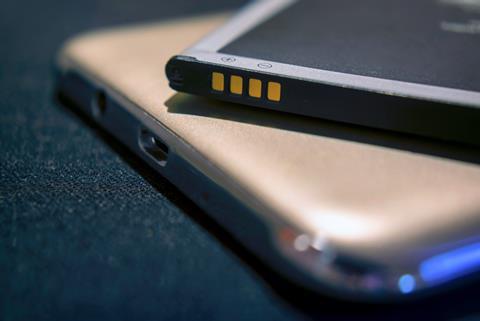Stephen Ashworth investigates the chemistry of the battery in your smartphone, and explains how you can build a simple electrochemical cell using everyday items from your home

Many of the devices we use today rely on battery power. Whatever kind of battery, large or small, rechargeable or not, they all have one thing in common: a chemical reaction provides the electrical power.
Many reactions involve the transfer of electrons between reaction partners. These are known as redox reactions as they involve the simultaneous reduction of one partner (which gains electrons) and oxidation of the other (which loses electrons). This is the sort of reaction we met in the test for vitamin C. In order to use such a reaction to provide electric current we need to be able to stop the electrons jumping straight from one partner to the other and make them flow through an electric circuit.
Many reactions involve the transfer of electrons between reaction partners. These are known as redox reactions as they involve the simultaneous reduction of one partner (which gains electrons) and oxidation of the other (which loses electrons). This is the sort of reaction we met in the test for vitamin C (https://edu.rsc.org/feature/what-is-vitamin-c-and-how-can-we-test-for-it/3007552.article). In order to use such a reaction to provide electric current we need to be able to stop the electrons jumping straight from one partner to the other and make them flow through an electric circuit.
Making hydrogen gas
When zinc is dissolved in an acid, bubbles of hydrogen are produced. The zinc metal forms zinc ions (Zn2+) and in doing so gives up two electrons. These electrons are captured by the hydrogen ions in solution, which then produce hydrogen gas. As zinc conducts electricity, we have the chance to allow those electrons to flow somewhere else and make the hydrogen there.
To do this we need one piece of zinc (eg from a nail) connected to a different metal that is also dipping into the acid. The pieces of metal in contact with the solution are called electrodes. If a piece of copper, such as a bare copper wire, is connected to the zinc and dipped in the same solution we have our two electrodes. Any acid can be used in the solution: vinegar is convenient but lemon juice works just as well (even when it is still in the lemon).
Some of the electrons produced when the zinc dissolves can now flow to the copper electrode. They can make hydrogen here rather than at the zinc electrode. If the piece of copper is big enough, all the electrons will flow from the zinc to the copper and bubbles of hydrogen will only be formed at the copper electrode.
Once all the zinc has dissolved, there will be no more chemical power to run the cell. It could, however, be recharged by connecting it to a suitable voltage source and supplying hydrogen to the copper electrode. This would remove electrons from the hydrogen, turning it into hydrogen ions, allowing the zinc ions to take up electrons and deposit zinc metal on the electrode again.
Try it yourself
Zinc and copper are not the only metals that can be used. Iron and copper or iron and zinc will both work. The voltage produced depends how easily the metal will dissolve in the acid. Iron dissolves less readily than zinc so it produces a lower voltage. A cell using zinc from a galvanised nail and a copper wire produces about 1 V. If you make three cells like this, using vinegar as the acid, and join them up in series to form a battery, you will produce a big enough voltage to light an LED.
You could also investigate the voltages of cells using other combinations of readily available metals, such as aluminium foil or iron nails. Although the voltage depends on the metals that are used, the current depends on the amount of metal in contact with the acid.
This is the principle behind the lemon and potato cells that can be found on the internet. The zinc electrode is dissolved by citric acid in a lemon and phosphoric acid in a potato. It is also the principle behind the first cells and batteries ever made – by the likes of Luigi Galvani and Alessandro Volta – and remains, in essence, the principle that allows this article to be read on a mobile device, like your phone.
This is the principle behind the lemon and potato cells that can be found on the internet (http://bit.ly/195BWOh). The zinc electrode is dissolved by citric acid in a lemon and phosphoric acid in a potato. It is also the principle behind the first cells and batteries ever made – by the likes of Luigi Galvani and Alessandro Volta – and remains, in essence, the principle that allows this article to be read on a mobile device, like your phone.

Sprout-tastic!
You can even make a battery from brussels sprouts! Take a look at how the Big Bang Fair used 1000 of them to light up an 8 foot Christmas tree.
You can even make a battery from brussels sprouts! Take a look at how the Big Bang Fair used 1000 of them to light up an 8 foot Christmas tree (http://bit.ly/IisFLV).
Additional information
This article originally appeared in The Mole, the student magazine published by the Royal Society of Chemistry from 2012 to 2015.









No comments yet